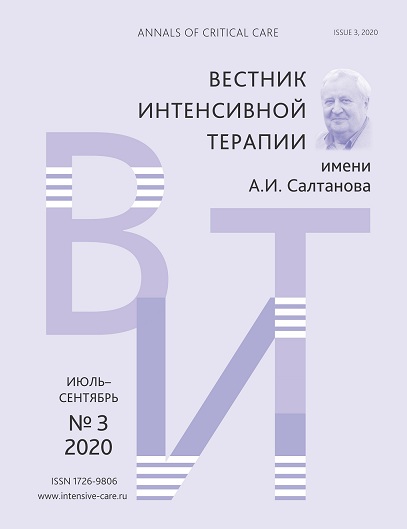Аннотация
Актуальность. Для пациентов с сохраненным спонтанным дыханием и дыхательной недостаточностью разработаны различные способы доставки газовой смеси в дыхательные пути. Открытым остается вопрос о выборе оптимальной методики при гипоксии у пациентов с тяжелой внебольничной пневмонией. Применение высокопоточной оксигенотерапии является альтернативой ингаляции кислорода через стандартные канюли.
Цели исследования. Экспериментальное изучение механизмов воздействия высокопоточной оксигенотерапии и оценка ее клинической эффективности в сравнении с традиционной оксигенотерапией у пациентов с тяжелой внебольничной пневмонией.
Материалы и методы. При проведении экспериментального этапа исследования определен уровень среднего давления в дыхательных путях в зависимости от потока газовой смеси с использованием модели легких с параметрами биомеханики дыхания, характеризующими «здоровые легкие», «легкие со сниженной растяжимостью» и «легкие с высоким сопротивлением дыхательных путей».
При проведении клинического этапа осуществлен сравнительный анализ эффективности респираторной поддержки в группах пациентов с тяжелой внебольничной пневмонией с использованием высокопоточной и традиционной оксигенотерапии.
Результаты. При проведении экспериментального исследования определен поток газовой смеси 30 л/мин, при котором значимо увеличивается среднее давление в дыхательных путях, регистрируемое на моделях «здоровых» легких и легких с измененной биомеханикой дыхания.
В ходе проведения клинического этапа исследования установлено значимое снижение частоты инициации искусственной (инвазивной и неинвазивной) вентиляции легких, увеличение показателей оксигенации (насыщение гемоглобина кислородом, парциальное давление кислорода в артериальной крови) и парциального давления углекислого газа в артериальной крови с одновременным снижением частоты дыхания.
Выводы. Величина потока газовой смеси более 30 л/мин значимо увеличивает среднее давление в дыхательных путях в эксперименте при моделировании «здоровых легких», «легких со сниженной растяжимостью» и «легких с высоким сопротивлением дыхательных путей». Однако клиническое значение данного показателя несущественно.
Использование высокопоточной оксигенотерапии у пациентов с тяжелой внебольничной пневмонией в сравнении со стандартной методикой уменьшает частоту применения искусственной (инвазивной и неинвазивной) вентиляции легких при увеличении показателей оксигенации. При этом уменьшается гипервентиляция, что подтверждается увеличением парциального давления углекислого газа в артериальной крови и снижением частоты дыхания.
Библиографические ссылки
- Ярошецкий А.И., Власенко А.В., Грицан А.И. и др. Применение неинвазивной вентиляции легких (второй пересмотр). Клинические рекомендации Общероссийской общественной организации «Федерация анестезиологов и реаниматологов». Анестезиология и реаниматология. Анестезиология и реаниматология. 2019; (6): 5–19. DOI: 10.17116/anaesthesiology20190615 [Yaroshetskiy A.I., Vlasenko A.V., Gritsan A.I., et al. Application of non-invasive ventilation (second revision). Clinical guidelines of the public organization “Russian Federation of Anesthesiologists and Reanimatologists”. Anesthesiology and Reanimatology. 2019; (6): 5–19. (In Russ)]
- Чучалин А.Г., Синопальников А.И., Козлов Р.С. Клинические рекомендации по диагностике, лечению и профилактике тяжелой внебольничной пневмонии у взрослых. Клиническая микробиология и антимикробная химиотерапия. 2015; 17(2): 84–127. DOI: 10.18093/0869-0189-2014-0-4-13-48 [Chuchalin A.G., Sinopalnikov A.I., Kozlov R.S. Clinical practice guidelines for the diagnosis, treatment and prevention of severe community-acquired pneumonia in adults. Clinical microbiology and antimicrobial chemotherapy. 2015; 17(2): 84–127. (In Russ)]
- Yealy D.M., Auble T.E., Stone R.A., et al. Effect of increasing the intensity of implementing pneumonia guidelines: a randomized, controlled trial. Annals of internal medicine. 2005; 143(12): 881–894. DOI: 10.7326/0003-4819-143-12-200512200-00006
- Almirall J., Bolıbar I., Vidal J., et al. Epidemiology of community-acquired pneumonia in adults: A population based study. European Respiratory J. 2000; 15(4): 757–763.
- Costa C., Gouveia I., Cunha P., et al. Severe community-acquired pneumonia in the intensive care unit. Critical Care. 2005; 9(1): 1. DOI: 10.1186/cc3064
- Федеральная служба по надзору в сфере защиты прав потребителей и благополучия человека [Internet] Available from: https://www.rospotrebnadzor.ru/documents/details.php?ELEMENT_ID=12053 (updated 20.07.2020; cited 21.07.2020).
- Gea J., Roca J., Torres A., Agustí A.G., et al. Mechanisms of abnormal gas exchange in patients with pneumonia. Anesthesiology: J. American Society of Anesthesiologists. 1991; 75(5): 782–789.
- Wijesinghe M., Perrin K., Healy B., Weatherall M., et al. Randomized controlled trial of high concentration oxygen in suspected community-acquired pneumonia. J. Royal Society of Medicine. 2012; 105(5): 208–216. DOI: 10.1258/jrsm.2012.110084
- Mandell L.A., Wunderink R.G., Anzueto A., et al. Infectious Diseases Society of America/American Thoracic Society consensus guidelines on the management of community-acquired pneumonia in adults. Clinical infectious diseases. 2007; 44(2): 27–72. DOI: 10.1086/511159
- Restrepo M.I., Mortensen E.M., Velez J.A., et al. A comparative study of community-acquired pneumonia patients admitted to the ward and the ICU. Chest. 2008; 133(3): 610–617. DOI: 0.1378/chest.07-1456
- Pinhu L., Whitehead T., Evans T., Griffiths M. Ventilator-associated lung injury. The Lancet. 2003; 361(9354): 332–340. DOI: 10.1016/S0140-6736(03)12329-X
- Hasan R.A., Habib R.H. Effects of flow rate and air leak at the nares and mouth opening on positive distending pressure delivery using commercially available high-flow nasal cannula systems: a lung model study. Pediatric Critical Care Medicine. 2011; 12(1): 29–33. DOI: 10.1097/PCC.0b013e3181d9076d
- Chikata Y., Onodera M., Oto J., Nishimura M. FIO2 in an adult model simulating high-flow nasal cannula therapy. Respiratory care. 2017; 62(2): 193–198. DOI: 10.4187/respcare.04963
- Ewig S., Woodhead M., Torres A. Towards a sensible comprehension of severe community-acquired pneumonia. Intensive Care Medicine. 2011; 37(2): 214–223. DOI: 10.1007/s00134-010-2077-0
- Sivieri E.M., Gerdes J.S., Abbasi S. Effect of HFNC flow rate, cannula size, and nares diameter on generated airway pressures: an in vitro study. Pediatric pulmonology. 2013; 48(5): 506–514. DOI: 10.1002/ppul.22636
- Lucangelo U., Vassallo F.G., Marras E., et al. High-flow nasal interface improves oxygenation in patients undergoing bronchoscopy. Critical care research and practice. 2012; 1–6. DOI: 10.1155/2012/506382
- Parke R., McGuinness S., Eccleston M. Nasal high-flow therapy delivers low level positive airway pressure. British J. Anaesthesia. 2009; 103(6): 886–890. DOI: 10.1093/bja/aep280
- Frat J.P., Ragot S., Girault C., et al. Effect of non-invasive oxygenation strategies in immunocompromised patients with severe acute respiratory failure: a post-hoc analysis of a randomised trial. The Lancet Respiratory Medicine. 2016; 4(8): 646–652. DOI: 10.1016/S2213-2600(16)30093-5
- Natalini D., Grieco D.L., Santantonio M.T., et al. Physiological effects of high-flow oxygen in tracheostomized patients. Annals of intensive care. 2019; 9(1): 1–9. DOI: 10.1186/s13613-019-0591-y
- Roca O., Riera J., Torres F., Masclans J.R. High-flow oxygen therapy in acute respiratory failure. Respiratory care. 2010; 201055(4): 408–413.


